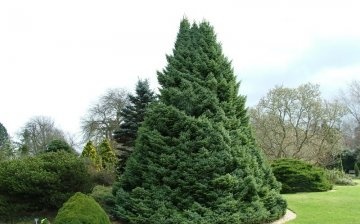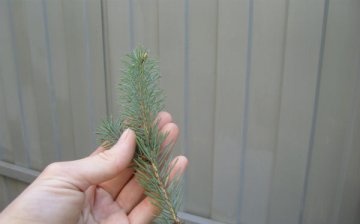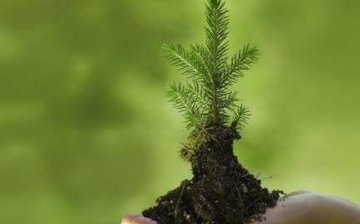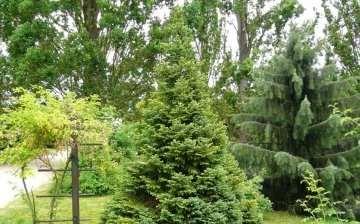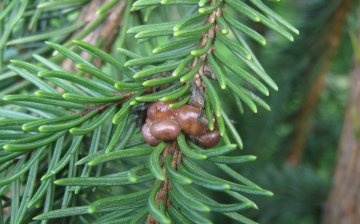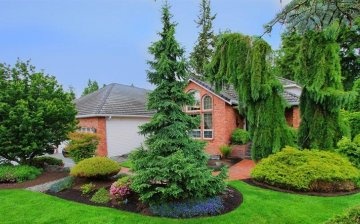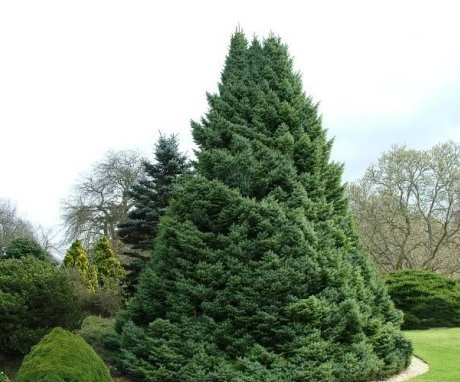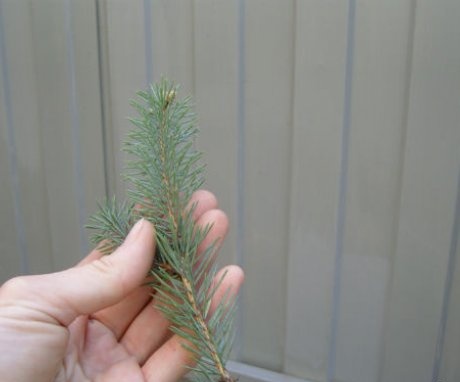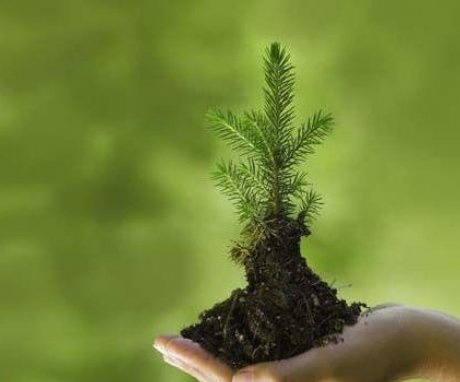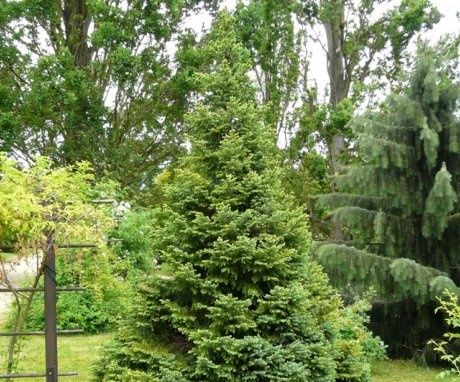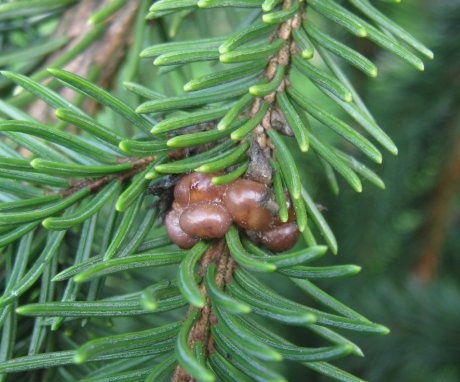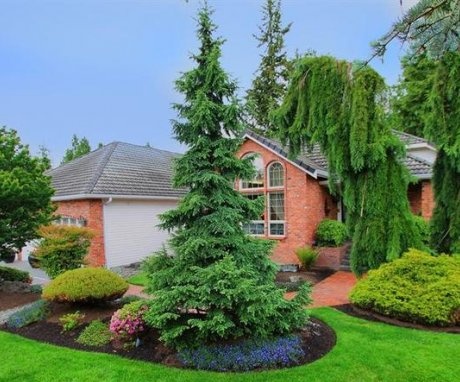Spruce cuttings: step by step instructions
Decorative views oil can decorate the garden area, make it truly original and unusual. In addition, they create shade, which is very important for summer vacations. The same must be remembered when choosing which crops to plant next to the trees - the shade can damage some plants, and stimulate others to develop.
Content:
- The best varieties of spruce for growing on the site
- Harvesting and germination of cuttings
- Terms and rules for planting cuttings in the ground
- Spruce care recommendations
- Possible growing problems
- The use of spruce in the design of the site
The best varieties of spruce for growing on the site
Spruce is a durable and original decoration of a garden plot. But not every tree is suitable for this purpose. Wild spruce trees grow for a very long time, are quite demanding on the soil, and also negatively affect other plants. Until beautiful spruces rustle on the site, many years will pass, and the beds for fruits and vegetables will be hopelessly ruined. To solve this problem, decorative spruce varieties were developed.
The common spruce has many varieties, including about 50 ornamental ones.
In height, these trees can be either medium-sized (3 or more meters) or dwarf - about 1.2 m in height. The advantage of this tree from the point of view of a gardener is that in favorable conditions the crown of the spruce itself forms a beautiful cone, without requiring pruning. It also retains a rich color at any time of the year. By the way, the colors of the needles are very diverse - golden, green, with a blue tint. This spruce is the least demanding on conditions. She needs adequate moisture and shade at an early age. Among the disadvantages is that the spruce does not get along with light-loving plants. It also severely depletes the soil, and the soil needs to be fertilized.
Thorny spruce (more than 70 ornamental varieties) has an unusual crown color. Its needles can be silver, steel or bluish-white. Trees are usually tall, dwarf forms are rare, and even they reach a height of 2m. The special thorniness of the needles, which gave the name to this species, allows it to be used as a natural guardian of the property - few people want to wade through the dense thorny needles. Among the disadvantages, this spruce grows longer than other decorative species.
Gray spruce, also called blue (about 20 ornamental varieties). It has not only a bluish-green color of needles, but also an ash-blue bark. The color of the needles can vary greatly from species to species and in different conditions. The shape of the crown differs in tall forms (cone-shaped) and dwarf (spherical or mushroom-shaped). This form arises on its own. The advantage is the beautiful appearance of the needles, as well as the independent formation of the crown. The disadvantage is that it is impossible to accurately predict the color of the needles, since it can change.
Harvesting and germination of cuttings
Cuttings - This is the propagation of a plant using branches. Reproduction by cuttings is also found in the wild, and on the garden plot it allows you to grow in itself exactly those spruces that the gardener needs.Cuttings should be harvested in April, preferably early in the morning, before sunrise.
What should be done:
- Choose a plant for propagation. It should be a healthy spruce at least 5 years old, well established on the soil. The branch, which will become a cutting, should also be healthy, there should be new sprouts of needles ("candles") on it. Cutting off a branch, you need to leave a heel - a fragment of the bark, so that the stalk takes root better. You need to remove the cuttings with a sharp knife.
- The soil in the pots must be prepared in advance. It should be a mixture of peat, sand and perlite, taken in equal proportions. You can buy a mixture of soil for conifers at the store.
The stalk is lowered into the ground, lightly tamped and watered. The stalk must be covered with a film or a mini-greenhouse from a plastic bottle (several holes must be made in it for air to enter). Watering the cutting should not be too often, focusing on the condition of the soil. Excessive watering can destroy the cutting.
The pot with the handle should be placed on the sunny side. In the summer, when the frost on the soil stops, you can transfer the cuttings to the greenhouse. This should be done with caution. If new green needles have appeared on the shoots, it means that they have successfully rooted.
Terms and rules for planting cuttings in the ground
Still, the ultimate goal of cuttings is to get a healthy and beautiful spruce growing in the open field. To do this, you need to transplant the rooted sprout from the greenhouse into the ground. This should be done no less than a year after the first transplant, when root system the sprout has already developed enough and has become capable of absorbing nutrients from the surrounding soil, and transplanting will not become a fatal stress for the plant.
The most suitable time for transplanting is late May - early June, in the northern regions this can be done later, in the southern ones earlier. The main thing is that during this period the threat of frost has already passed, but the summer heat has not yet come. The plant must be at least a year old from the date of receipt of the cuttings, if in doubt, you can wait another six months. The second favorable period is September, when the heat has already subsided, but it is still not too cold at night. This is a riskier time to transplant.
In order to transplant a young tree, you need:
- Prepare the recess in advance. This should be a fairly deep hole in which drainage should be put - small pebbles or special drainage from a store, sand, and specially purchased soil for this type of conifers.
- Then you should carefully dig the plant out of the greenhouse. You need to do this at a short distance from the trunk so as not to damage the roots. It should be remembered that the spruce root system is superficial, therefore, the lump should be of a large area, but not too high. This way the largest number of small roots is preserved.
- The tree, together with the earthen lump, must be transferred into the recess, and carefully transplanted. From above, the roots need to be strengthened with earth, watered with a small amount of water.
- The root collar (the area where the trunk passes into the roots) should be located above the ground.
- Newly planted spruce should be protected from physical damage until it takes root in new soil.
Spruce care recommendations
The most important tips for caring for spruce:
- It is often necessary to loosen the soil around the tree. This should be done at least twice a year, using a hoe or hoe. It is important not to dig too deep to avoid damaging the roots. You need to loosen the soil very carefully so as not to disturb the root system, especially the small roots.
- Despite the fact that the spruce itself does an excellent job of forming a beautiful crown, you need to regularly remove dried branches so that they do not interfere with the development of healthy branches. Sometimes the crown of the spruce can bifurcate, and then it is better to remove one of the tops so that the shape of the crown remains beautiful.
- You need to feed it with a special feeding for conifers, do it in the spring before the first young shoots appear, but after the snow melts. You can combine this procedure with loosening the soil. More often than once a year, there is no need to fertilize, but less often it should not be - this will lead to a rapid depletion of the soil and the death of the plant.
Spruce is quite resistant to pests, but it is affected by the spruce sawfly. He gnaws young twigs, and they look burnt. To do this, you should use medicines for pests of spruce trees.
Possible growing problems
Problems can be related to mistakes during the transplant. For example, if an earthen lump around the roots was disturbed, then the spruce does not take root well. New roots are not formed, and old ones are damaged. Such a tree can easily dry out and die even with proper watering and care.
When choosing branches for cuttings, you should pay attention that these are branches as close to the top as possible. Cuttings from lateral branches quite often branch, bend, give many side shoots. This does not allow the spruce to grow beautiful and healthy.
You should also pay close attention to the place where the fir trees are planted - it should be a shaded place away from groundwater.
Drainage is required - without it, the plant will rot. The soil next to the trunk must be loose and must not be trampled. It should be noted that other conifers have different soil requirements. The planting hole should be deep enough. In this case, the rule is that more is better than less. You don't have to bury a large hole until the end, and the plant adapts to it, but a small hole is guaranteed to destroy it.
Pests should be treated immediately. Ate is quite resistant to them, but if they get sick, then it is very contagious - one affected tree can become a source of infection for all neighboring plants. Signs of pests are bright colored spots on the trunk, as well as burnt branches.
The use of spruce in the design of the site
Spruce in landscape design is quite complex. Most often, it is planted as an independent plant around houses or gazebos to create shade in them. Dwarf forms can be used as hedges - they are prickly and thick enough to cope with the functions of a fence.
It is difficult to combine spruce with other ornamental plants - it blocks the sunlight for them and depletes the soil. Of those who can live with spruce without harm to themselves, pansies and Japanese anemones look the most advantageous.
More information can be found in the video:




